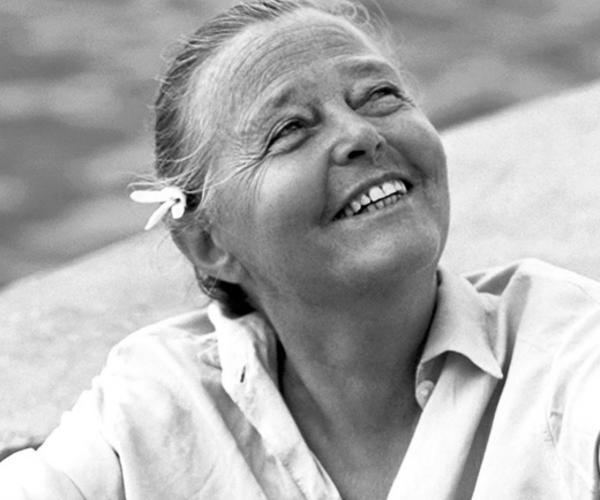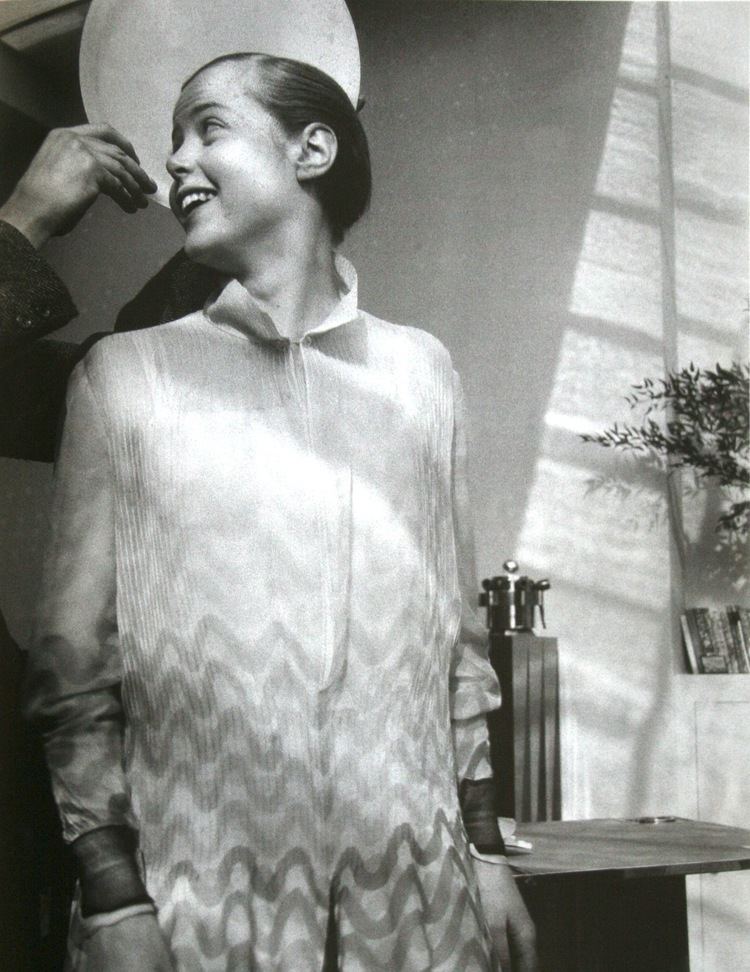Nationality French Occupation Architect | Name Charlotte Perriand Role Architect | |
 | ||
Alma mater Ecole de L'Union Centrale de Arts Decoratifs Spouse(s) Percy Kilner Scholefield Died October 27, 1999, Paris, France Books Charlotte Perriand, a Life of Creation, Une vie de création | ||
Charlotte perriand s louis vuitton beach house
Charlotte Perriand (24 October 1903 – 27 October 1999) was a French architect and designer. Her work aimed to create functional living spaces in the belief that better design helps in creating a better society. In her article "L’Art de Vivre" from 1981 she states "The extension of the art of dwelling is the art of living—living in harmony with man’s deepest drives and with his adopted or fabricated environment."
Contents
- Charlotte perriand s louis vuitton beach house
- Charlotte perriand designer photographer activist
- Early life
- Career
- Work with Le Corbusier 1927 1937
- Japan Vietnam 1940 1946
- The Chaise Longue
- Personal life
- Timeline
- References

Charlotte perriand designer photographer activist
Early life

Perriand was born in Paris, France to a tailor and a seamstress. Her high school art teacher noticed her drawing abilities early on, and her mother eventually encouraged her to enroll in the Ecole de L'Union Centrale de Arts Decoratifs ("School of the Central Union of Decorative Arts") in 1920 to study furniture design until 1925. One of her noted teachers during this period was Art Deco interior designer Henri Rapin. Perriand continued her education through attending department store classes that provided design workshops. She also went to lectures by Maurice Dufrene, the studio director of 'La Maitrise' worksop. In 1925, her projects from schoolwork were selected to be a part of the Exposition Internationale des Arts Decortifs et Industriels Modernes. Dufrene also put her wall-hanging designs on display at the Galeries Lafayette around this time.
Career

Only two years after graduating Perriand renovated her apartment into a room with a built in wall bar made of aluminum, glass and chrome and a card table with built in pool-pocket drink holders. She recreated this design as the Bar sous le toit (Bar in the attic) at the 1927 Salon d'Automne. It was full of gleaming aluminum and nickel coated surfaces, leather cushions and glass shelves, and her design received wide praise from the press at the time. The design caused a sensation and established Perriand as a talent to watch. The Bar sous le toit showed her preference for designs that represented the age of the machine, which went away from the preference of finely handcrafted objects made of rare woods. Perriand took advantage of the use of steel as a medium in this project, which used to be used only by men. Despite the Bar sous le toit's success in getting her name known, Perriand was not satisfied with creating designs just for the well-off, she wanted to work for Le Corbusier and pursue serial production and low cost housing. She was inspired by Le Corbusier's books, because she thought his writings that criticized the decorative arts aligned with the way she designed.

She applied to work at Le Corbusier's studio in October 1927 she was famously rejected with the reply "We don’t embroider cushions here." A month later, Le Corbussier visited her show at the Salon d’Automne, convincing him to offer her a job in furniture design.
Work with Le Corbusier 1927 - 1937

At Le Corbusier's studio, she was in charge of their interiors work and promoting their designs through a series of exhibitions. Perriand described the work as being highly collaborative between Le Corbusier, Pierre Jeanneret, and herself, they were "three fingers on one hand."
In 1928 she designed three chairs from Corbusier's principles that the chair was a "machine for siting," and that each of the three would accommodate different positions for different tasks. At Corbuiser's request a chair was made for conversation: the B301 sling back chair, another for relaxation: the LC2 Grand Comfort chair, and the last for sleeping: the B306 chaise longue. Each chair had a chromium-plated tubular steel base.
In the 1930s, Perriand’s focus became more egalitarian and populist. Along with designing furniture and living spaces, she was also involved with many leftist organizations such as the Association des Écrivains et Artistes Révolutionnaires, and Maison de la Culture. She also collaborated with the Jeunes in 1937 and help to found The Union des Artistes Modernes. In her designs from that period, rather than using chrome, which proved to be expensive, she began to use traditional materials such as wood and cane, which were more affordable. She also used some handcrafted techniques which she displayed at the 1935 Brussels International Exhibition. Many of her designs from this period were inspired from the vernacular furniture of Savoie where her grandparents lived—a place she visited often as a child.
Japan & Vietnam 1940-1946
After finishing her work with Le Corbusier, she worked with Jean Prouve. He designed metal objects, like screens and stair railings. The war turned their focus to designing military barracks and furnishings for temporary housing. In 1940 France surrendered, and they parted ways until 1951. Perriand left France to go to Japan when the Germans arrived to occupy Paris in 1940. She traveled to Japan as an official advisor for industrial design to the Ministry for Trade and Industry. While in Japan she advised the government on raising the standards of design in Japanese industry to develop products for the West. On her way back to Europe she was detained and forced into Vietnamese exile because of the war. Throughout her exile she studied woodwork and weaving and also gained much influence from Eastern design. The Book of Tea which she read at this time also had a major impact on her work and she referenced it throughout the rest of her career.
In the period after World War II (1939–45) there was increased interest in using new methods and materials for mass production of furniture. Manufacturers of materials such as formica, plywood, aluminum, and steel sponsored the salons of the Société des artistes décorateurs. Designers who exhibited their experimental work at the salons in this period included Perriand, Pierre Guariche, René-Jean Caillette, Jean Prouvé, Joseph-André Motte, Antoine Philippon and Jacqueline Lecoq. Return to Paris 1946 -
Charlotte Perriand work was in high demand and she worked on many projects from ski resorts to student housing. She often refused to furnish buildings designed by other architects. However, she was eager to work with Jean Prouvé who collaborated with her on and produced several of her designs from 1951 to 1953. Charlotte Perriand took part in the design of the ski resorts of Les Arcs in Savoie from 1967-1982. She designed the interiors and kitchens for the famous Unité d'habitation.
Some of her work includes:
The Chaise Longue
Perriand was familiar with Thonet's bentwood chairs and used them often not only for inspiration but also in her designs. Their chaise longue, for this reason, bears some similarity to Thonet's bentwood rocker although it doesn't rock. The chair has double tubing at the sides and a lacquered sheet metal base. The legs unintentionally resemble horse hooves. Perriand took this and ran with it, finding pony skin from Parisian furriers to cover the chaise. Perriand wrote in a memoir, "While our chair designs were directly related to the position of the human body...they were also determined by the requirements of architecture, setting, and prestige". With a chair that reflects the human body (thin frame, cushion/head) and has decorative qualities (fabrication, structural qualities) they accomplished this goal. It wasn't instantly popular due to its formal simplicity but as modernism rose, so did the chair's popularity.
Personal life
In 1926 Perriand married her first husband, Percy Kilner Scholefield, and they converted their attic apartment into a 'machine age' interior. They had one daughter, Pernette Perriand. She worked alongside her mother for over 25 years. In 1930 Charlotte and Percy separated and she moved to Montparnasse.
She died three days after her 96th birthday.
